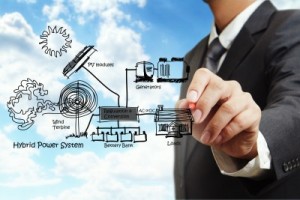CAN NORTH SEA HARBOURS HARNESS ENERGY?
CAN NORTH SEA HARBOURS HARNESS ENERGY?
Researchers from Robert Gordon University (RGU) will help lead an international conference this month examining how North Sea harbours can effectively harness smart energy solutions.
The conference, which will be hosted at Stromness Town Hall on Tuesday, February 25, is being organised as part of European research project e-harbours, in partnership with Heriot-Watt University Orkney Campus. The event will focus on the energy network challenges faced in Orkney and how they can be addressed using the smart energy solutions identified by e-harbours partners in ports across Europe.
The event will examine how smart energy systems and electric vehicles can help local electricity grids absorb increasing volumes of renewable energy and better balance energy demand with increasingly intermittent supply.
David Gray, professor of transport policy at RGU, has overseen the university’s contribution to the project, working with researchers in the Centre for Understanding Sustainable Practice (CUSP).
He said: “A lot of issues that Orkney is facing at the moment will be faced by the rest of Europe in the coming years – it is a microcosm of Europe. This essentially relates to the increase in the use of renewable energy and the impact that is having on the energy grid.
“For example, in Orkney, the electricity grid is highly constrained and – at certain times – it cannot cope with the energy produced by the large number of large and micro-wind turbines which have been connected in recent years. Turbines have to be switched off as a result, and valuable renewable energy is not being captured.
“In the long term what needs to be looked at is an overhaul of energy grids across Europe to allow the grid to be able to cope with the increasing use of renewable energy sources. In the short and medium term there is a need to look at the use of smart energy solutions to balance the energy supply and demand.”

Prof. Gray, who will also talk at a final e-harbours conference in Holland this month, explained: “A simply analogy of what smart energy systems actually do is to think about your domestic appliances at home – your washing machines and dishwashers. By linking these up to a smart meter, they will automatically turn on when there is low energy demand or when energy is at its cheapest. In that way, you can balance out your demand for energy at a time when there is an excess of supply.
“The e-harbours project has been looking at how to exploit such flexibility on a larger scale across North Sea harbours which are massive consumers of energy. Unless we start to develop some of these solutions, a return to the days of power cuts might not be too far off.”
Prof. Gray has also been involved in the benchmarking side of the project, leading the development of a methodology to compare the effectiveness and transferability of different types of smart initiatives.
Other strands of the project, led by partners across Europe, include looking at the potential to switch energy intensive industrial process to off peak times, more closely managing the energy consumption of refrigeration containers, developing smart systems for recharging electric vehicles and looking at the potential savings from energy efficiency and local awareness raising in small ports.
To register for the conference: visit www.icit.hw.ac.uk
For further information about the e-harbours project: www.eharbours.eu

